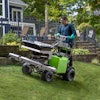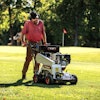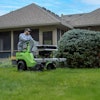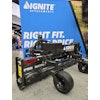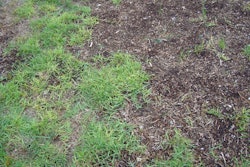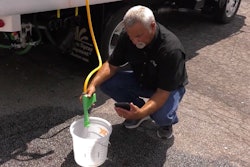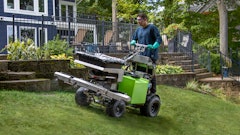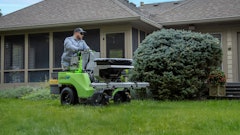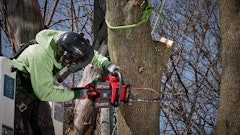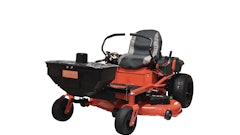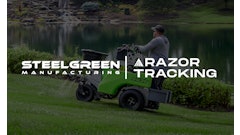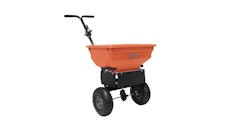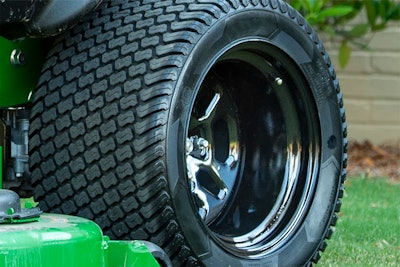
Many turf professionals have seen or heard about the new flat-free, or airless, tire options available for turf care equipment. However, many fleets are still using traditional pneumatic tires.
To a lot of people, the concept of a tire that never goes flat sounds too good to be true. Otherwise, why wouldn’t everybody be using them by now?
Let’s explore the benefits of the latest flat-free tire options. And, more importantly, see how you can achieve return on investment in no time flat…literally.
Ride quality
One of the main benefits of pneumatic tires is the ride quality, as the air helps absorb impacts. As a result, many people ask how a flat-free tire can possibly ride as nicely without air.
The answer is technology. Engineers have developed advanced compounds and different designs to achieve a flat-free design that feels like it’s riding on air. Some designs on the market utilize an inner hub structure of deformable plastic structures (i.e., spokes) that are designed to flex under load and subsequently return to their original shape.
Other designs combine multilayered construction, engineered structural supports and a tread belt all within the tire itself to maintain desired curvature at all times. Furthermore, some of these tires are designed with a deflection management system that reduces deflection (for example, the amount of bulge the tire lowers under load as weight or torque is applied) and optimizes energy absorption and load distribution. As a result, flat-free tire manufacturers are confident in saying the ride is similar to what pneumatic tires provide.
Load support
Beyond ride dampening, some of today’s flat-free tires are also designed to support heavy loads with no impact on performance or changes in ride height. Depending on the flat-free tire design, even damaged tires may be capable of supporting weight without issue.
Tire life
Some people may assume that flat-free tires have a similar wear life—or less—than a traditional pneumatic tire. In fact, flat-free tires can be expected to last longer, even when carrying heavy loads or after sustaining damage.
Today, tire manufacturers have high enough confidence in their tire solutions that they’re offering warranties as long as three years on flat-free turf tires as a testament to the longevity of them.
Cost
When it comes to pricing, flat-free tires do cost more upfront, but it’s easy to figure how much faster the investment can pay for itself. While calculations will differ for each operation, let’s consider a realistic scenario of a year-round lawn mowing service.
For example, if a machine experiences an average of one flat tire every other week, that equals up to 26 flat tires annually. Each time a tire goes flat, an operator may experience two hours of downtime, which can add up to $300 per incident through lost productivity and labor costs. Twenty-six tires at $300 per incident means $7,800 in downtime per year for each machine in the fleet. The number is multiplied if more than one machine is owned, potentially reaching tens of thousands of dollars in opportunity costs.
And, as with many new technologies, with more acceptance and adoption, prices tend to fall. This has been the case with flat-free tires, which have significantly decreased in price over recent years. If a contractor had looked into flat-free tires before and shied away due to cost, it might be time to look again.
While all of these benefits sound great, there are actually other advantages to flat-free tires. For instance, they offer exceptional traction, grip and handling on rough terrain. Also, the wide contact patch enhances stability and braking, while being gentle on turf.
Flat-free tires have environmental benefits as well. Because flat-free tires last longer than pneumatic tires, there is less waste. These are benefits that not only positively affect contractors’ bottom lines, but they can also market flat-free tire use as a green initiative.
Options for all operations
Unlike many pneumatic wheel options, flat-free tires are sold as an assembly with the tire and wheel included. It’s a bolt-on replacement for stock tires and wheels that easily installs—just bolt the new assemblies to the hub.
Considering all these benefits, the latest flat-free tire advancements are sucking some air out of arguments for traditional pneumatic tires. Technology has reached a point to where pneumatic tires hold little—if any—advantages over flat-free. Many manufacturers expect the industry to continue shifting toward flat-free solutions. Turf professionals who haven’t made the switch yet should consider setting the wheels in motion themselves. It can be a simple way to reduce operational headaches while adding more air under the bottom line.

